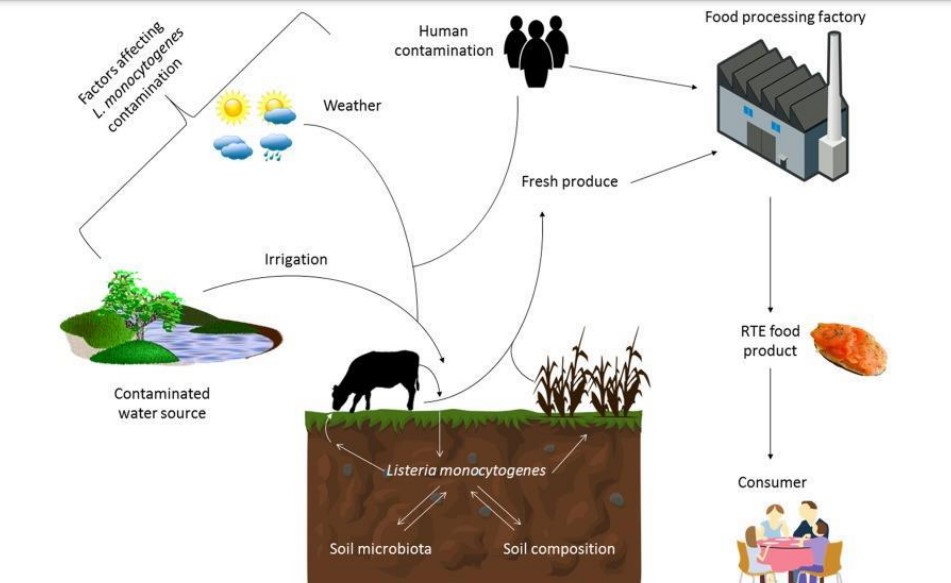A study conducted during 2019 to 2020, by a team of experts at the University of Pretoria (UP) into the prevalence of foodborne pathogen Listeria monocytogenes in beef and beef products at some abattoirs and retailers in Gauteng, Mpumalanga and North-West provinces, has produced some interesting outcomes with concerning implications for consumers.
The research by UP’s Faculty of Veterinary Science and the Agricultural Research Council-Onderstepoort Veterinary Institute (ARC-OVI) showed that, among other findings, 4.6% of chilled carcasses sampled at seven abattoirs in one of the provinces were contaminated with Listeria monocytogenes. This means that contaminated carcasses have the potential to enter the food chain as beef and beef products sold at retail outlets in the province.
Listeria monocytogenes is a foodborne pathogen that causes listeriosis, a life-threatening disease that could cause miscarriage and stillbirth among pregnant women. Most human cases are associated with the consumption of ready-to-eat foods, and the risk of illness increases with the number of cells ingested. The pathogen is able to survive and multiply at the refrigerated temperatures at which foods are stored to prevent spoilage.
“Processed foods become contaminated by contact with equipment, the handling of raw products, or from post-processing settings in which the pathogen can survive despite the routine use of disinfectants,” said Dr Rebone Moerane, Head of UP’s Department of Production Animal Studies, who was part of the research team along with Professor Abiodun Adesiyun, an extraordinary professor in the department, Dr Nomakorinte Gcebe of the ARC-OVI, and four postgraduate students.
“Because of potential contamination during slaughter, carcasses can become contaminated, leading to contaminated meat and meat products,” Dr Moerane added. “A wide variety of foods – including beef, pork, poultry and milk-based products – have been reported to harbour the pathogen and cause listeriosis among consumers.”
The study, which was funded by the Red Meat Research and Development South Africa, was prompted by the 2017-2018 outbreak of listeriosis in the country, which led to 1 060 confirmed cases and about 216 deaths. Processed products – polony, in particular – were suspected of being the main source of the outbreak.
“With this study, we sought to investigate the prevalence and molecular characterisation of pathogenic serotypes [a distinguishable strain of a microorganism] of Listeria monocytogenes in beef and beef products in Gauteng, Mpumalanga, and the North West,” Prof Adesiyun said.
The study also set out to determine the prevalence and factors associated with the pathogen in cattle, silage, feeds, and water on farms in the three provinces; in slaughtered cattle and carcasses at processing plants; and the prevalence and factors associated with the contamination of beef and beef products at retail outlets.
Research was conducted at the three levels of beef production. Samples of faeces, feeds, silage, and water were collected from cattle farms; carcass swabs were taken from abattoirs, as were samples of faeces and effluents; and samples of raw beef and beef products (including ready-to-eat items) were collected from retail outlets of all sizes.
Some of the serotypes of Listeria monocytogenes detected by the team, belong to serogroups which are well known to have the potential to cause human listeriosis. In addition, for the virulence genes selectively assayed, the detection frequency ranged from 12.5% to 50%, 21.9% to 100% and 81.8% to 100% in North West, Mpumalanga, and Gauteng respectively.
The researchers found that the risk of exposure of cattle to listeriosis on farms is minimal. However, the detection of 4.6% of chilled carcasses sampled at Gauteng abattoirs being contaminated with Listeria monocytogenes is troubling, as are the findings at retail outlets.
“The prevalence of the pathogen was 6%, 8.3%, and 9.3% in beef and beef products sampled in outlets in North West, Mpumalanga, and Gauteng respectively, and 4.3%, 11% and 9.3% for cold beef and beef products,” Dr Moerane explained. “Some of the contaminated products were ready-to-eat items – including polony [6.9% – 16.7%], which is widely consumed, and biltong [3.6% – 10.3%]. This increases the risk of human exposure to the pathogen.”
Fortunately, the researchers observed that, in most cases, all the Listeria monocytogenes isolates responded to penicillin, ampicillin and sulfamethoxazole-trimethoprim (SXT), which are important antimicrobials used in the treatment of listeriosis.
“However, the high occurrence of multi-drug-resistant strains of Listeria monocytogenes cannot be ignored, as they may pose therapeutic challenges,” Prof Adesiyun cautioned. “This is because of the potential transfer of resistance within and between bacterial species.”
Listeria monocytogenes poses a serious foodborne challenge to consumers. As such, the UP team recommends that government, in collaboration with industry partners, implement stringent food safety measures at abattoirs and processing plants to reduce contamination and lower the possibility of another listeriosis outbreak.
The team has also recommended follow-up studies of moist biltong, which is widely consumed in the country, to determine its ability to support the growth of the pathogen and assess the risk posed to consumers.
The high prevalence of resistance to certain antimicrobial agents assessed in addition to the detection of several multi-drug-resistant strains and resistance patterns could be attributed to the uncontrolled use and sale of antimicrobial agents on cattle farms. The transmission of antimicrobial-resistant Listeria monocytogenes to consumers may have therapeutic implications.
“There is an urgent need to expand on research on antimicrobial resistance, to educate farmers on the use of such products, to review the availability of over-the-counter products, and monitor the use of antimicrobial agents in the livestock industry,” Prof Adesiyun said.
“It’s our hope that government and industry stakeholders will act on these findings and introduce strict control and monitoring measures at the appropriate stages in the beef production system,” Dr Moerane said. “It’s vital that we use the outcomes of this study to get ahead of another potential outbreak of listeriosis.”
Source: University of Pretoria









